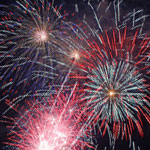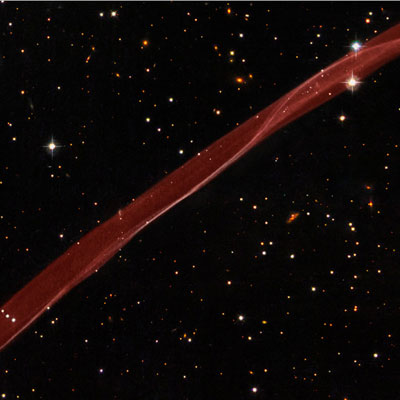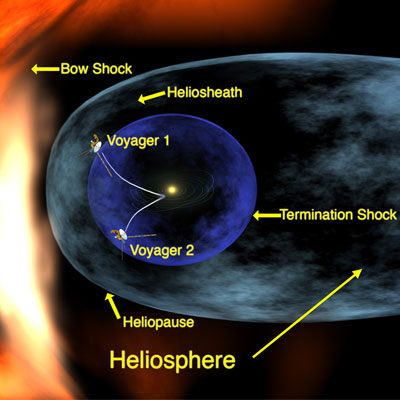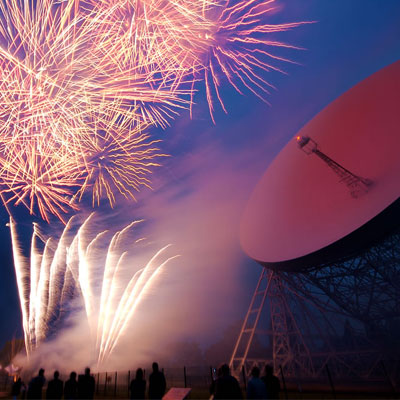 Happy Independence Day to everyone in the US (and happy Friday to everyone else)! In honor of the 4th of July, we have compiled some fireworks facts, cool video and info on why fireworks aren’t the only thing lighting up tonight’s sky. Plus we have news on a possible Nexus, potential future V’Gers and much more.
Happy Independence Day to everyone in the US (and happy Friday to everyone else)! In honor of the 4th of July, we have compiled some fireworks facts, cool video and info on why fireworks aren’t the only thing lighting up tonight’s sky. Plus we have news on a possible Nexus, potential future V’Gers and much more.
Hubble Finds The Nexus
A delicate ribbon of gas floats eerily in our galaxy. Have we finally found The Nexus? Actually this image, taken by NASA’s Hubble Space Telescope, is a very thin section of a supernova remnant caused by a stellar explosion that occurred more than 1,000 years ago. But, so far, scientists cannot comment on whether or not entering this energy ribbon will transport you to an imaginary land of euphoria. Only one way to find out!

Someone blow up some stars so this thing’ll come to Earth!
The Laboratory at the End of the Solar System
Launched in 1977, Voyager 2 was sent out to boldly study the solar system and beyond. Just over 30 years later, it reached what is known as the termination shock, the point where the solar wind slows to speeds below the speed of sound (relative to the interstellar medium). Prior to the actual event, researchers had expected a fairly simple crossing. What they found instead was a “complex, rippled, quasi-perpendicular supercritical magnetohydrodynamic shock (what a mouthful!) of moderate strength undergoing reformation on a scale of a few hours.” No word yet on when one of the Voyagers will fall into a black hole and be sent to the machine planet.

A diagram showing the heliosphere and Voyager 1 & 2’s trajectories
The Science of Fireworks
10 things you didn’t know about fireworks:
- Legend has it that the Chinese made the first fireworks in the 800s, filling bamboo shoots with gunpowder and exploding them at the New Year with the hope that the sound would scare away evil spirits.
- Fireworks became known in Europe during the 1300s, probably after returning Crusaders brought them from the East.
- Different colors in fireworks are created by using different chemicals: Copper for blue, aluminum and magnesium for gold or white, barium for green, strontium for red, and sodium for yellow.
- In 1996, a string of firecrackers were lit that lasted 22 hours for the Chinese New Year in Hong Kong.
- Static electricity in synthetic clothing can ignite fireworks. Those who make fireworks wear cotton all the way down to their underwear.
- The most dangerous fireworks-related tragedy in the world occurred on May 16, 1770, during the marriage of King Louis XVI to Marie Antoinette. After the celebratory fireworks show, there was a stampede where approximately 800 people where killed.
- How high up a firework will fly depends on its size. A simple rule of thumb in calculating how high a firework will ascend before it explodes is 100 feet of altitude for every inch of shell diameter, so a 12-inch shell explodes 1,200 feet in the air.
- Just what makes flashes of light in the sky on the Fourth of July patriotic? On the first Fourth of July celebration in 1776, Philadelphia patriots lit their windows with candles to let all know where they stood. Those loyal to the English crown kept their panes dark.
- What makes the weeping willow effect in a firework? Charcoal burns longer than explosive black powder’s other ingredients. It is bits of charcoal—like the glowing embers in your barbecue – that drift slowly down to create the weeping willow effect.
- The wailing shrieks of certain “whistler” shells are the result of burning sodium salicytate—a chemical added to fireworks to create just such a delightful sound. Interestingly, sodium salicytate is closely related to aspirin, which can quiet post-Fourth headaches.
Also, In honor of Independence day in the US, we’ve brought you a neat video which explains why we love fireworks, a bit of their history, and how they work.
Planets Align for the 4th of July
Tonight, look beyond the fireworks. Almost halfway up the western sky, just above the twilight glow of sunset, a trio of worlds is gathering: Saturn, Mars and the crescent Moon. Red Mars and ringed Saturn will converge just to the left of the bright star Regulus. The three lights make a pretty 1st-magnitude line in the heavens: sky map. But that is just the beginning. Tomorrow, July 5th, a lovely crescent Moon joins the show. Saturn, Mars, and the Moon trace an even brighter line than the night before: sky map.

Fireworks aren’t the only show in the sky this holiday weekend
Video of the Week
The Phoenix mission gets a little air time on The Daily Show this week. Check it out!
Gadget of the Week: The UBiqWindow — Google Earth Hologram Device
If you can forgive the strange soundtrack, this video is a nice look into some awesome, and completely real, holographic technology in which you can experience Google Earth in a whole new way.
Science Quickies
Here’s a warp-speed look at science tid-bits that didn’t quite make the cut, but nonetheless merit mention.
- How the Next Mission to the Moon will work
- New discoveries at Mercury
- Asteroid anniversary recalls Earth’s rocky history
- Cassini ends 4 year mission, begins next chapter
(Thanks, Judy and Gar and others for the tips!)

Ah, the one day where it’s legal (in most states) and proper to blow the crap out of stuff. I love America. And is that Hologram actually real?!
I think I’m having a heart attack…
Please state the nature of the medical emergency.
Kayla — I was feelin’ all smart n’ stuff til I got to #4 on your fireworks list.
Hmm. Bested again! I will have my revenge yet.
Nice wrap-up. Happy 4th, K.
I absolutely love Google Earth. The ability to virtually travel anywhere on Earth is a blast. Happy 4th!
This holographic google earth looks really awesome.
What better way to show the love for one’s country than to blow up a small piece of it.
Hey! Happy 4th to everyone!
wow it really is the nexus…..
i love it when they find stuff from movies…
reminds me of a year or so ago when they found some genuine Kryptonite….then supermans fortress in a cave in mexico….then a large habitable ice planet obiting a red sun in another galaxy
And they said that Voyager would last this long!!! Got a love those NASA engineers!!
Isn’t that Copper for Green?
the holographic globe looks like something out of astrometrics in Star Trek…
#9. I thought copper was green as well, like in a flame test. But, maybe it’s different when you’re exploding it?
Happy 4th everyone.
Love the Google Earth thing. Wish my navigation was that good.
Back to inebriation and fireworks.
Maybe they can find Voyager in the Delta Quadrant.
The US Government in its infinite wisdom is trying to close down Aricebo, our eye on the sky with regards to the search for radio signals from Extraterrestrial intelligence. It’s the huge dish seen in the movie ‘Contact’.
Two bills are pending to save it; both are apparently in trouble. Senate Bill S.2862 and House Resolution H.R. 3737 would insure funding continues.
I am a Seti@home volunteer, my PC runs 24 hours per day and runs their software full tilt when I am not using the CPU cycles.
Bug your Senators and Congressman.
It’s real life, gang — and it’s important.
11.
I think it depends on what copper compound you are using. Some give blue, some green, some are blue-green.
Another great job Kayla!
I was wondering if there is a “pull back” shot on the energy ribbon showing the entire structure?
16.
Here it is in yellow:
http://antwrp.gsfc.nasa.gov/apod/ap080704.html
RE the UBiqWindow: WOW. That is incredible. Movie special effects come to life.
Wow, the Nexus and Voyager.
“What’s that?”-Guinan
“That’s history fullfilling itself.”-Picard
Those new Saturn images are amazing.
Thanks!